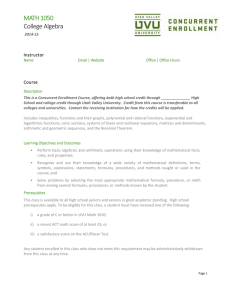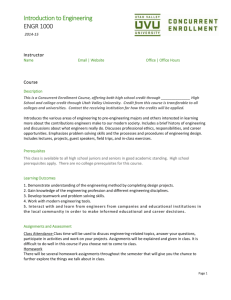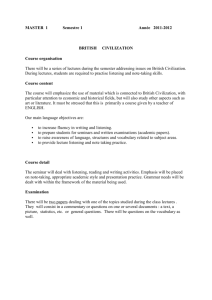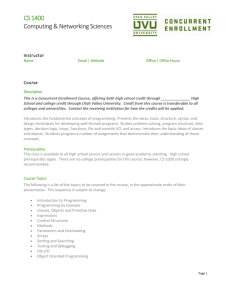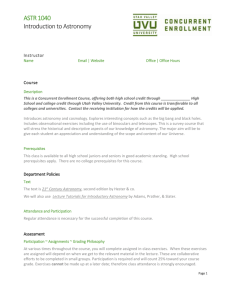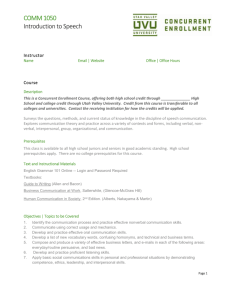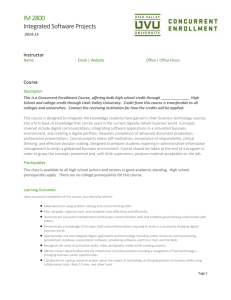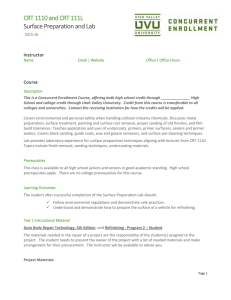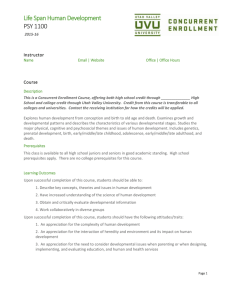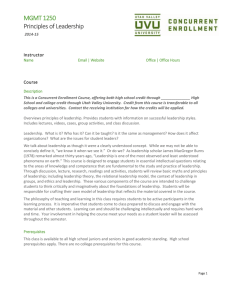MUSC 1030 American Popular Music
advertisement
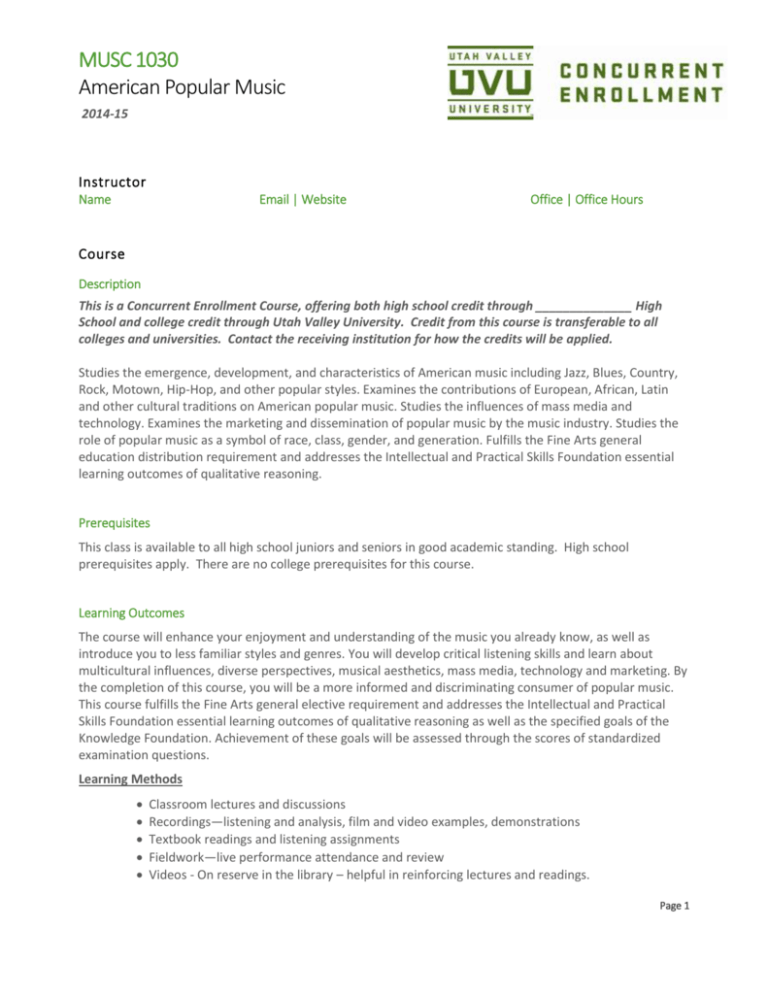
MUSC 1030 American Popular Music 2014-15 Instructor Name Email | Website Office | Office Hours Course Description This is a Concurrent Enrollment Course, offering both high school credit through ______________ High School and college credit through Utah Valley University. Credit from this course is transferable to all colleges and universities. Contact the receiving institution for how the credits will be applied. Studies the emergence, development, and characteristics of American music including Jazz, Blues, Country, Rock, Motown, Hip-Hop, and other popular styles. Examines the contributions of European, African, Latin and other cultural traditions on American popular music. Studies the influences of mass media and technology. Examines the marketing and dissemination of popular music by the music industry. Studies the role of popular music as a symbol of race, class, gender, and generation. Fulfills the Fine Arts general education distribution requirement and addresses the Intellectual and Practical Skills Foundation essential learning outcomes of qualitative reasoning. Prerequisites This class is available to all high school juniors and seniors in good academic standing. High school prerequisites apply. There are no college prerequisites for this course. Learning Outcomes The course will enhance your enjoyment and understanding of the music you already know, as well as introduce you to less familiar styles and genres. You will develop critical listening skills and learn about multicultural influences, diverse perspectives, musical aesthetics, mass media, technology and marketing. By the completion of this course, you will be a more informed and discriminating consumer of popular music. This course fulfills the Fine Arts general elective requirement and addresses the Intellectual and Practical Skills Foundation essential learning outcomes of qualitative reasoning as well as the specified goals of the Knowledge Foundation. Achievement of these goals will be assessed through the scores of standardized examination questions. Learning Methods Classroom lectures and discussions Recordings—listening and analysis, film and video examples, demonstrations Textbook readings and listening assignments Fieldwork—live performance attendance and review Videos - On reserve in the library – helpful in reinforcing lectures and readings. Page 1 Course Requirements | Assessment Course Requirements: 1. Reading/Listening. Each week, you will need to complete reading and listening assignments before coming to class. The classroom lectures and discussions are designed to reinforce the reading and listening assignments, not replace them. Be prepared. 2. Class Attendance. Attendance in class is essential for a better understanding of the materials in the textbook and is a part of your overall grade. 3. Review of a Live Performance. Paper must be 3 pages in length using the following format: a. Name, Date & Section (Class Time) must be single-spaced and right justified at top right corner. b. Body of paper double-spaced. c. Margins at 1 inch all around. d. Font no larger than 12 point. Paper MUST be stapled at upper left corner– no paper clips, folding, etc. Paper MUST include proof of attendance stapled to the back of your paper (ticket stub, program, photos, etc.) The performance you attend must be during the current semester and in a popular music genre. Due: Last day of class. You may (and are encouraged to) turn it in any time before the due date. The performance you attend must be during the dates of the current semester – a concert seen before or after this semester is NOT acceptable. The performance can be any style or genre of popular music that relates to the material covered in this class (for example -- folk, country, bluegrass, swing, big band, jazz, rock, blues, or musical theater). Ask yourself if the music you are listening to relates to the music we have studied (or will study) in this class. Performances in the classical music category are NOT acceptable (e.g., classical chamber music, symphony orchestra). If in doubt, please check with me. Part of the assignment is to locate live music in various genres. There are a number of venues in town where you can see live music; many of them are free. Check the listings in the newspaper. You might try to model your review after one found in a newspaper, magazine, or online source. Answer or comment on some of these questions: • When and where was the performance? • Who were the performers? What was the instrumentation? What pieces did they play? • Who was in the audience, and did the audience seem to enjoy the performance? • How would you rate the quality of the performance? 2 Not all of these questions will be relevant, and you may have other questions that you would like to ask. In your review, include information you discovered about the artist(s) through websites, other reviews, or your own personal interviews. If you talk to the performers, show respect for them and their music. You might start by introducing yourself, explaining the assignment, and telling them what you really enjoyed about their performance. You might—if appropriate—ask them a few questions. For example: What bands or musicians influenced you the most? What are your future plans with your music? Do not ask questions such as: What meter did you play in tonight? What tune/key were the songs in? What was the form of the songs? If you have had little or no experience with music before this class and can’t hear specific musical elements, describe what you CAN hear (e.g., the music was fast and energetic; the band sounded like a train). Remember, I want you to think and write creatively about the music. Your writing should be somewhat formal; do not use casual language. 4. Exams. There will be four exams during the semester. Exam questions will include material taken from lectures/discussions, reading/listening assignments, and videos shown in class. The exams will consist of multiple choice and true/false questions. Final grades will be calculated as follows: Exams 1 – 4 = 80% Review of Live Performance = 20% Department Grading Scale A = 100-93 A - = 92-90 B+ = 89-87 B = 86-83 B - = 82-80 C+ = 79-77 C = 76-73 C - = 72-70 D+ = 69-67 D = 66-63 D - = 62-60 F = 59-0 Page 3 Grades and Credit You will receive the same grade for your high school course as you receive for your college course. Your grade for this class will become part of your permanent college transcript and will affect your GPA. A low grade in this course can affect college acceptance and scholarship eligibility. University Academic Integrity Utah Valley University expects all students to maintain integrity and high standards of individual honesty in academic work, to obey the law, and to show respect for others. Students of this class are expected to support an environment of academic integrity, have the right to such an environment, and should avoid all aspects of academic dishonesty. Examples of academic dishonesty include plagiarizing, faking of data, sharing information during an exam, discussing an exam with another student who has not taken the exam, consulting reference material during an exam, submitting a written assignment which was authored by someone other than you, and/or cheating in any form. Violators of this policy will be subject to disciplinary action. Cheating will not be tolerated. It will result in a FAILING grade for the course. In keeping with UVU policy, evidence of academic dishonesty may result in a failing grade in the course and disciplinary review by the college. Additional information on this topic is published in the student handbook and is available on the UVU website. Students with Disabilities If you have any disability, which may impair your ability to successfully, complete this course, please contact the Accessibility Services office, 863-8747, BU 146. Academic accommodations are granted for all students who have qualified documented disabilities. All services are coordinated with the Accessibility Services office. Dropping the Class _________ is the last day to drop the course without it showing on your transcript. _________ is the last day to withdraw from the class. If you drop the high school class, you must also withdraw from the UVU class to avoid receiving an E or UW (unofficial withdrawal). 4
